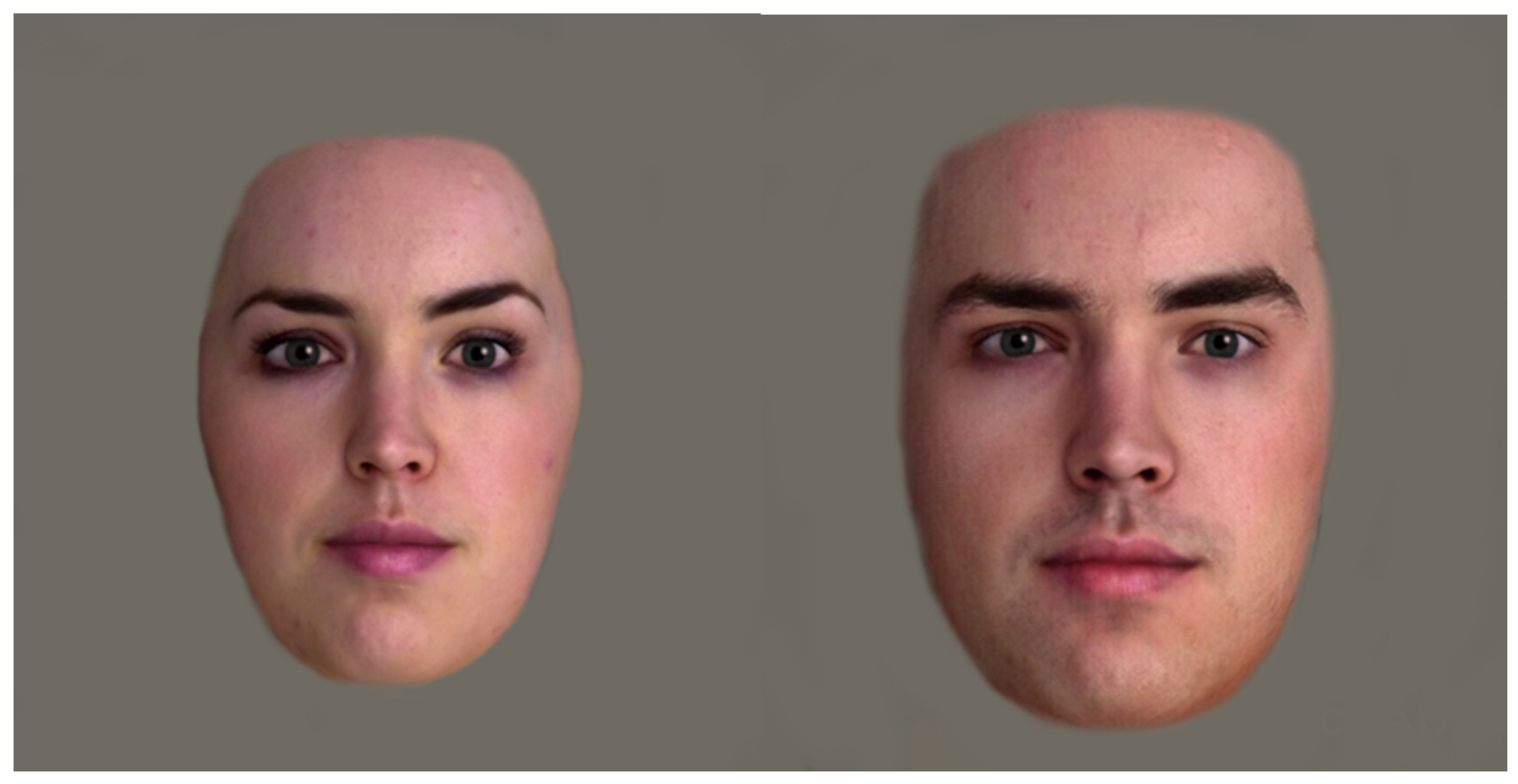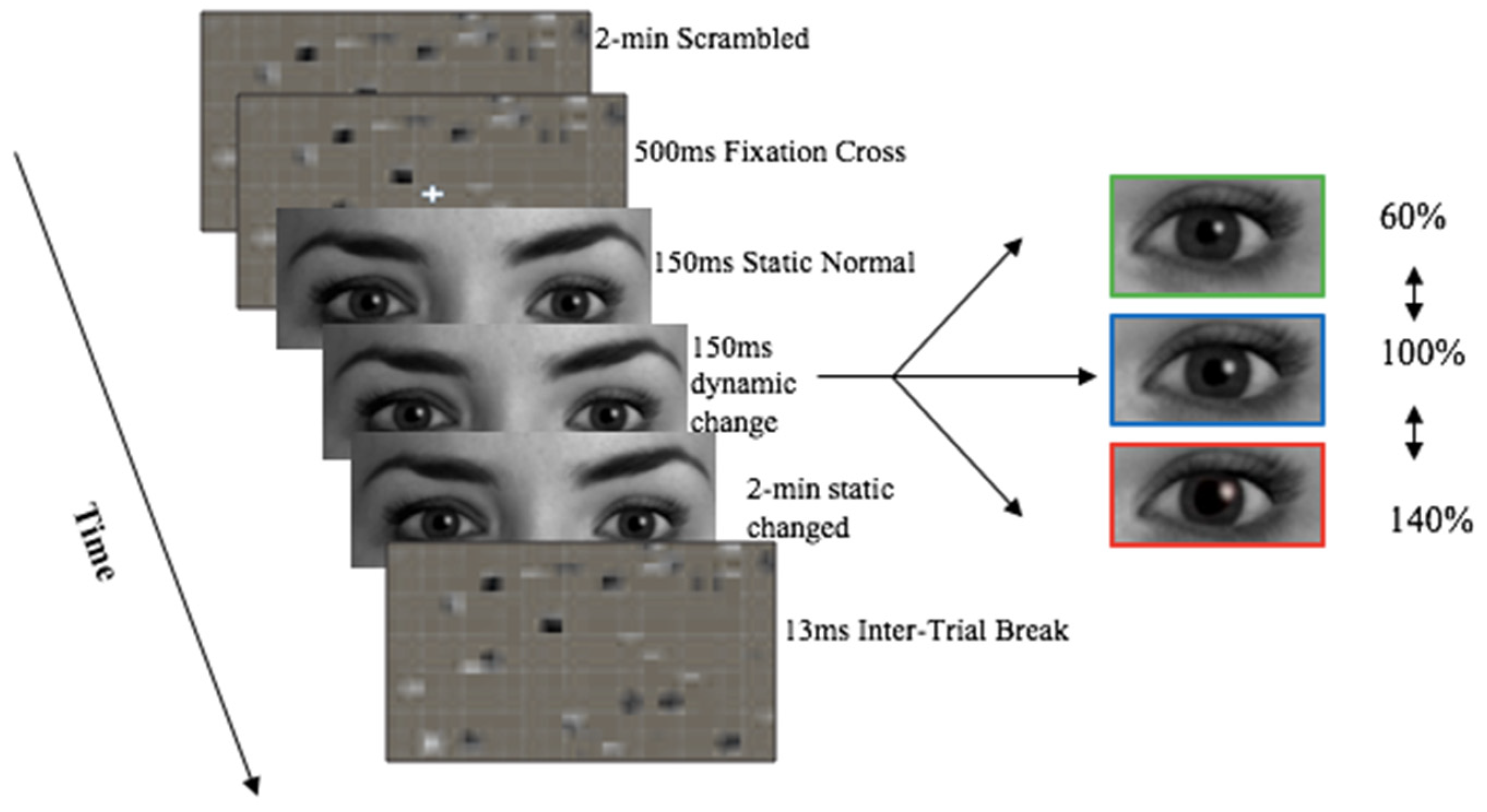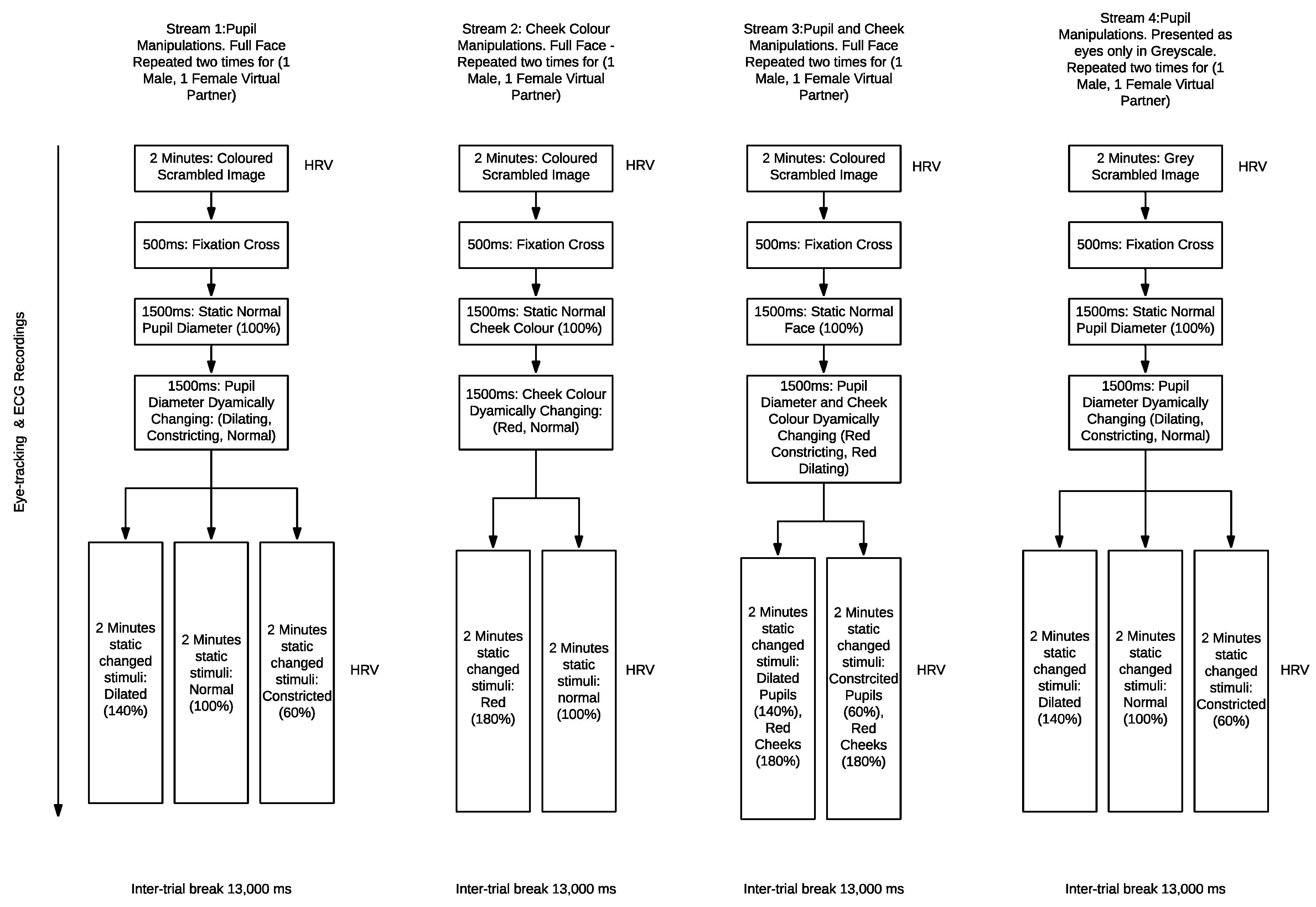Human and Human-Interfaced AI Interactions: Modulation of Human Male Autonomic Nervous System via Pupil Mimicry
Abstract
:1. Introduction
2. Materials and Methods
2.1. Study Population
2.2. Stimuli
- Stream 1: Full face in colour with pupil manipulations: dilated, constricted, normal (Figure 2),
- Stream 2: Full face in colour with cheek colour manipulations: red.
- Stream 3: Full face in colour with manipulations of pupil size and cheek colour: pupils constricted-cheeks red, pupils dilated-cheeks red. The experimental control condition was the un-changed condition, where pupil size and cheek colour stays normal (100%).
- Stream 4: Cropped eyes in grey scale pupil size manipulations: Normal, dilated, constricted (Figure 3).
2.3. Experimental Procedure
2.4. Experimental Design
2.5. Physiological Measurement and Equipment
2.6. Data Analysis
2.7. Statistical Analysis
3. Results
3.1. Response to Pupil Manipulations of Virtual Partners Presented as a Full Face in Colour
3.2. Response to Pupil Manipulations of Virtual Partners Presented as a Cropped Eye Region in Grey Scale
3.3. Response to Blush of Virtual Partners
3.4. Response to Simultaneous Blush and Pupil Manipulations in Virtual Partners
4. Discussion
4.1. Right vs. Left Pupil Response
4.2. Pupil Constriction vs. Dilation
4.3. Grey Scale Cropped Region
4.4. Blush
4.5. Male vs. Female/Gender Effects
4.6. Limitations & Future Research
5. Conclusions
Supplementary Materials
Author Contributions
Funding
Institutional Review Board Statement
Informed Consent Statement
Data Availability Statement
Acknowledgments
Conflicts of Interest
References
- Seymour, M.; Riemer, K.; Kay, J. Actors, avatars and agents: Potentials and implications of natural face technology for the creation of realistic visual presence. J. Assoc. Inf. Syst. 2018, 19, 953–981. [Google Scholar] [CrossRef]
- Prochazkova, E.; Kret, M.E. Connecting minds and sharing emotions through mimicry: A neurocognitive model of emotional contagion. Neurosci. Biobehav. Rev. 2017, 80, 99–114. [Google Scholar] [CrossRef]
- Kret, M.E. Emotional expressions beyond facial muscle actions. A call for studying autonomic signals and their impact on social perception. Front. Psychol. 2015, 6, 711. [Google Scholar] [CrossRef] [Green Version]
- Kret, M.E.; Tomonaga, M.; Matsuzawa, T. Chimpanzees and humans mimic pupil-size of conspecifics. PLoS ONE 2014, 9, e104886. [Google Scholar] [CrossRef]
- Van Breen, J.A.; De Dreu, C.K.; Kret, M.E. Pupil to pupil: The effect of a partner’s pupil size on (dis) honest behavior. J. Exp. Soc. Psychol. 2018, 74, 231–245. [Google Scholar] [CrossRef] [Green Version]
- Dijk, C.; Koenig, B.; Ketelaar, T.; De Jong, P.J. Saved by the blush: Being trusted despite defecting. Emotion 2011, 11, 313–319. [Google Scholar] [CrossRef] [Green Version]
- Hess, E.H. Attitude and pupil size. Sci. Am. 1965, 212, 46–54. [Google Scholar] [CrossRef]
- Kret, M.E.; Fischer, A.H.; De Dreu, C.K.W. Pupil mimicry correlates with trust in in-group partners with dilating pupils. Psychol. Sci. 2015, 26, 1401–1410. [Google Scholar] [CrossRef] [Green Version]
- Pumprla, J.; Howorka, K.; Groves, D.; Chester, M.; Nolan, J. Functional assessment of heart rate variability: Physiological basis and practical applications. Int. J. Cardiol. 2002, 84, 1–14. [Google Scholar] [CrossRef]
- Acharya, U.R.; Joseph, K.P.; Kannathal, N.; Lim, C.M.; Suri, J.S. Heart rate variability: A review. Med. Biol. Eng. Comput. 2006, 44, 1031–1051. [Google Scholar] [CrossRef]
- Prochazkova, E.; Prochazkova, L.; Giffin, M.R.; Scholte, H.S.; De Dreu, C.K.W.; Kret, M.E. Pupil mimicry promotes trust through the theory-of-mind network. Proc. Natl. Acad. Sci. USA 2018, 115, E7265–E7274. [Google Scholar] [CrossRef] [Green Version]
- Fleenor, B.S. Large elastic artery stiffness with aging: Novel translational mechanisms and interventions. Aging Dis. 2013, 4, 76–83. [Google Scholar]
- Gomez, P.; Guten, A.V.; Panuser, B. Autonomic nervous system reactivity within the valence-arousal affective space: Modulation by sex and age. Int. J. Psychophysiol. 2016, 109, 51–62. [Google Scholar] [CrossRef] [Green Version]
- Drummond, P.D.; Lim, H.K. The significance of blushing for fair- and dark-skinned people. Pers. Individ. Differ. 2000, 29, 1123–1132. [Google Scholar] [CrossRef]
- Bradley, M.M.; Miccoli, L.; Escrig, M.A.; Lang, P.J. The pupil as a measure of emotional arousal and autonomic activation. Psychophysiology 2008, 45, 602–660. [Google Scholar] [CrossRef] [Green Version]
- Dain, S.J. Clinical colour vision tests. Clin. Exp. Optom. 2004, 87, 276–293. [Google Scholar] [CrossRef]
- Bourdillon, N.; Schmitt, L.; Yazdani, S.; Vesin, J.-M.; Millet, G.P. Minimal window duration for accurate HRV recording in athletes. Front. Neurosci. 2017, 11, 456. [Google Scholar] [CrossRef]
- Kubios, O. HRV Manual (2016–2019). Available online: www.kubios.com (accessed on 2 February 2021).
- Tarvainen, M.P.; Niskanen, J.-P.; Lipponen, J.A.; Ranta-Aho, P.O.; Karjalainen, P.A. Kubios HRV—Heart rate variability analysis software. Comput. Methods Programs Biomed. 2014, 113, 210–220. [Google Scholar] [CrossRef]
- Jarrin, D.C.; McGrath, J.; Giovanniello, S.; Poirier, P.; Lambert, M. Measurement fidelity of heart rate variability signal processing: The devil is in the details. Int. J. Psychophysiol. 2012, 86, 88–97. [Google Scholar] [CrossRef] [Green Version]
- McCraty, R.; Shaffer, F. Heart Rate Variability: New perspectives on physiological mechanisms, assessment of self-regulatory capacity, and health risk. Glob. Adv. Health Med. 2015, 4, 46–61. [Google Scholar] [CrossRef] [Green Version]
- Litvack, D.A.; Oberlander, T.F.; Carney, L.H.; Saul, J.P. Time and frequency domain methods for heart rate variability analysis: A methodological comparison. Psychophysiology 1995, 32, 492–504. [Google Scholar] [CrossRef]
- Baevsky, R.M.; Chernikova, A.G. Heart rate variability analysis: Physiological foundations and main methods. Cardiometry 2017, 66–76. [Google Scholar] [CrossRef] [Green Version]
- Cakır, A.; Alptekin, K.; Özden, A.; Öncü, J. Immediate effects of chiropractic thoracic manipulations on the autonomic nervous system. J. Orthop. Trauma Surg. Relat. Res. 2019, 14. [Google Scholar]
- Trivedi, G.Y.; Saboo, B. A Comparative study of the impact of Himalayan singing bowls and supine silence on stress index and heart rate variability. J. Behav. Ther. Ment. Health 2019, 2, 40–50. [Google Scholar] [CrossRef]
- Shirole, U.; Joshi, M.; Bagul, P. Cardiac, diabetic and normal subjects classification using decision tree and result confirmation through orthostatic stress index. Inform. Med. Unlocked 2019, 17, 100252. [Google Scholar] [CrossRef]
- Ayuso-Moreno, R.M.; Fuentes-García, J.P.; Collado-Mateo, D.; Villafaina, S. Heart rate variability and pre-competitive anxiety according to the demanding level of the match in female soccer athletes. Physiol. Behav. 2020, 222, 112926. [Google Scholar] [CrossRef]
- Roos, L.E.; Knight, E.L.; Beauchamp, K.G.; Berkman, E.T.; Faraday, K.; Hyslop, K.; Fisher, P.A. Acute stress impairs inhibitory control based on individual differences in parasympathetic nervous system activity. Biol. Psychol. 2017, 125, 58–63. [Google Scholar] [CrossRef] [Green Version]
- Pagani, M.; Lombardi, F.; Guzzetti, S.; Rimoldi, O.; Furlan, R.; Pizzinelli, P.; Sandrone, G.; Malfatto, G.; Dell’Orto, S.; Piccalugaet, E.; et al. Power spectral analysis of heart rate and arterial pressure variabilities as a marker of sympatho-vagal interaction in man and conscious dog. Circ. Res. 1986, 59, 178–193. [Google Scholar] [CrossRef] [Green Version]
- Kret, M.E.; De Dreu, C.K.W. Pupil-mimicry conditions trust in partners: Moderation by oxytocin and group membership. Proc. R. Soc. B Boil. Sci. 2017, 284, 20162554. [Google Scholar] [CrossRef] [Green Version]
- Liu, Y.; Rodenkirch, C.; Moskowitz, N.; Schriver, B.; Wang, Q. Dynamic lateralization of pupil dilation evoked by locus coeruleus activation results from sympathetic, not parasympathetic, contributions. Cell Rep. 2017, 20, 3099–3112. [Google Scholar] [CrossRef]
- Lichtenstein-Vidne, L.; Gabay, S.; Cohen, N.; Henik, A. Lateralisation of emotions: Evidence from pupil size measurement. Cogn. Emot. 2017, 31, 699–711. [Google Scholar] [CrossRef]
- Wang, C.-A.; Munoz, D.P. A circuit for pupil orienting responses: Implications for cognitive modulation of pupil size. Curr. Opin. Neurobiol. 2015, 33, 134–140. [Google Scholar] [CrossRef]
- Hess, E.H.; Polt, J.M. Pupil size as related to interest value of visual stimuli. Science 1960, 132, 349–350. [Google Scholar] [CrossRef]
- Wang, C.; Baird, T.; Huang, J.; Coutinho, J.D.; Brien, D.C.; Munoz, D.P. Arousal effects on pupil size, heart rate, and skin conductance in an emotional face task. Front. Neurol. 2018, 9, 1029. [Google Scholar] [CrossRef]
- Bandura, A.; Rosenthal, T.L. Vicarious classical conditioning as a function of arousal level. J. Pers. Soc. Psychol. 1996, 3, 54–62. [Google Scholar] [CrossRef]
- Rimm-Kaufman, S.E.; Kagan, J. The psychological significance of changes in skin temperature. Motiv. Emot. 1996, 20, 63–78. [Google Scholar] [CrossRef]
- Harrison, N.A.; Singer, T.; Rotshtein, P.; Dolan, R.J.; Critchley, H.D. Pupillary contagion: Central mechanisms engaged in sadness processing. Soc. Cogn. Affect. Neurosci. 2006, 1, 5–17. [Google Scholar] [CrossRef]







| Male | Female | |||||||||||
|---|---|---|---|---|---|---|---|---|---|---|---|---|
| Normal | Constricted | Dilated | Normal | Constricted | Dilated | |||||||
| Mean | SD | Mean | SD | Mean | SD | Mean | SD | Mean | SD | Mean | SD | |
| RMSSD | 35.037 | 12.278 | 34.379 | 14.237 | 37.366 | 14.039 | 35.101 | 16.917 | 37.230 | 19.852 | 37.992 | 24.870 |
| SI | 11.091 | 3.479 | 12.024 | 4.918 | 10.862 | 3.885 | 12.298 | 4.482 | 11.756 | 4.091 | 11.586 | 4.034 |
| PNS | −0.589 | 0.835 | −0.554 | 0.947 | −0.525 | 0.751 | −0.785 | 0.864 | −0.691 * | 0.982 | −0.882 * | 0.753 |
| SNS | 1.113 | 1.544 | 0.971 | 1.109 | 0.835 | 1.029 | 1.222 | 1.220 | 1.113 | 1.358 | 1.171 | 1.328 |
Publisher’s Note: MDPI stays neutral with regard to jurisdictional claims in published maps and institutional affiliations. |
© 2021 by the authors. Licensee MDPI, Basel, Switzerland. This article is an open access article distributed under the terms and conditions of the Creative Commons Attribution (CC BY) license (http://creativecommons.org/licenses/by/4.0/).
Share and Cite
Spicer, C.; Khwaounjoo, P.; Cakmak, Y.O. Human and Human-Interfaced AI Interactions: Modulation of Human Male Autonomic Nervous System via Pupil Mimicry. Sensors 2021, 21, 1028. https://doi.org/10.3390/s21041028
Spicer C, Khwaounjoo P, Cakmak YO. Human and Human-Interfaced AI Interactions: Modulation of Human Male Autonomic Nervous System via Pupil Mimicry. Sensors. 2021; 21(4):1028. https://doi.org/10.3390/s21041028
Chicago/Turabian StyleSpicer, Catherine, Prashanna Khwaounjoo, and Yusuf Ozgur Cakmak. 2021. "Human and Human-Interfaced AI Interactions: Modulation of Human Male Autonomic Nervous System via Pupil Mimicry" Sensors 21, no. 4: 1028. https://doi.org/10.3390/s21041028
APA StyleSpicer, C., Khwaounjoo, P., & Cakmak, Y. O. (2021). Human and Human-Interfaced AI Interactions: Modulation of Human Male Autonomic Nervous System via Pupil Mimicry. Sensors, 21(4), 1028. https://doi.org/10.3390/s21041028







